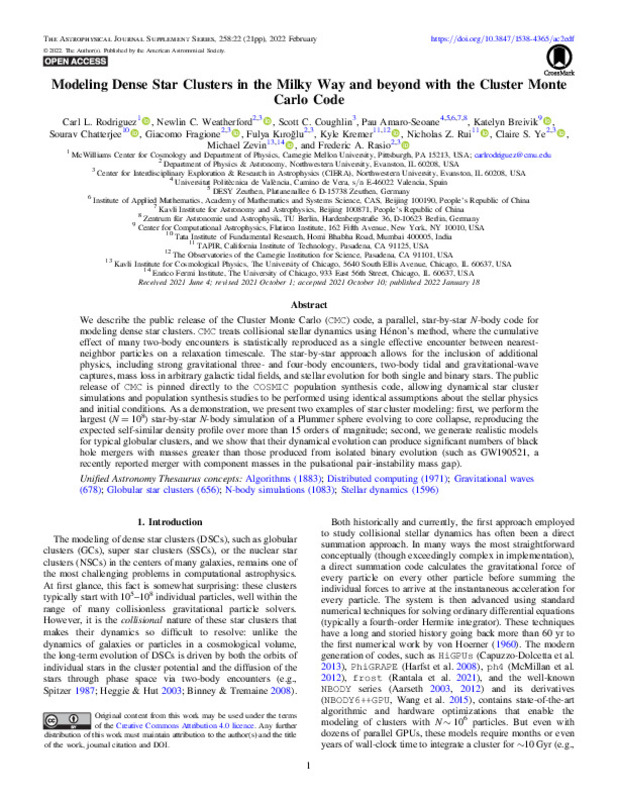JavaScript is disabled for your browser. Some features of this site may not work without it.
Buscar en RiuNet
Listar
Mi cuenta
Estadísticas
Ayuda RiuNet
Admin. UPV
Modeling Dense Star Clusters in the Milky Way and beyond with the Cluster Monte Carlo Code
Mostrar el registro sencillo del ítem
Ficheros en el ítem
| dc.contributor.author | Rodriguez, Carl L.
|
es_ES |
| dc.contributor.author | Weatherford, Newlin C.
|
es_ES |
| dc.contributor.author | Coughlin, Scott C.
|
es_ES |
| dc.contributor.author | Amaro-Seoane, Pau
|
es_ES |
| dc.contributor.author | Breivik, Katelyn
|
es_ES |
| dc.contributor.author | Chatterjee, Sourav
|
es_ES |
| dc.contributor.author | Fragione, Giacomo
|
es_ES |
| dc.contributor.author | Kiroglu, Fulya
|
es_ES |
| dc.contributor.author | Kremer, Kyle
|
es_ES |
| dc.contributor.author | Rui, Nicholas Z.
|
es_ES |
| dc.contributor.author | Ye, Claire S.
|
es_ES |
| dc.contributor.author | Zevin, Michael
|
es_ES |
| dc.contributor.author | Rasio, Frederic A.
|
es_ES |
| dc.date.accessioned | 2023-07-24T18:02:33Z | |
| dc.date.available | 2023-07-24T18:02:33Z | |
| dc.date.issued | 2022-02-01 | es_ES |
| dc.identifier.issn | 0067-0049 | es_ES |
| dc.identifier.uri | http://hdl.handle.net/10251/195421 | |
| dc.description.abstract | [EN] We describe the public release of the Cluster Monte Carlo (CMC) code, a parallel, star-by-star N-body code for modeling dense star clusters. CMC treats collisional stellar dynamics using Henon's method, where the cumulative effect of many two-body encounters is statistically reproduced as a single effective encounter between nearest-neighbor particles on a relaxation timescale. The star-by-star approach allows for the inclusion of additional physics, including strong gravitational three- and four-body encounters, two-body tidal and gravitational-wave captures, mass loss in arbitrary galactic tidal fields, and stellar evolution for both single and binary stars. The public release of CMC is pinned directly to the COSMIC population synthesis code, allowing dynamical star cluster simulations and population synthesis studies to be performed using identical assumptions about the stellar physics and initial conditions. As a demonstration, we present two examples of star cluster modeling: first, we perform the largest (N = 10(8)) star-by-star N-body simulation of a Plummer sphere evolving to core collapse, reproducing the expected self-similar density profile over more than 15 orders of magnitude; second, we generate realistic models for typical globular clusters, and we show that their dynamical evolution can produce significant numbers of black hole mergers with masses greater than those produced from isolated binary evolution (such as GW190521, a recently reported merger with component masses in the pulsational pair-instability mass gap). | es_ES |
| dc.description.sponsorship | We thank Kuldeep Sharma, Xiaoqi Yu, and Mike Grudic for testing this release of CMC and providing feedback, and Elena Gonzalez and Miguel Martinez for useful comments and discussions. This work was supported by NSF grant AST2009916 at Carnegie Mellon University, a New Investigator Research Grant to C.R. from the Charles E. Kaufman Foundation, and NSF grant AST-1716762 at Northwestern University. This work used the Extreme Science and Engineering Discovery Environment (XSEDE), which is supported by National Science Foundation grant No. ACI-1548562. Specifically, it used the Bridges-2 system, which is supported by NSF award No. ACI-1928147, at the Pittsburgh Supercomputing Center (PSC). N.C.W. acknowledges support from the CIERA Riedel Family Graduate Fellowship. F.K. acknowledges support from the Turkish Fulbright Commission. K.K. is supported by an NSF Astronomy and Astrophysics Postdoctoral Fellowship under award AST-2001751. P.A.-S. acknowledges support from the Ramon y Cajal Programme of the Ministry of Economy, Industry and Competitiveness of Spain, as well as the financial support of Programa Estatal de Generacion de Conocimiento (ref. PGC2018-096663-B-C43) (MCIU/FEDER). N.Z.R. acknowledges support from the Dominic Orr Graduate Fellowship at Caltech. | es_ES |
| dc.language | Inglés | es_ES |
| dc.publisher | American Astronomical Society | es_ES |
| dc.relation.ispartof | The Astrophysical Journal Supplement Series | es_ES |
| dc.rights | Reconocimiento (by) | es_ES |
| dc.subject.classification | MATEMATICA APLICADA | es_ES |
| dc.title | Modeling Dense Star Clusters in the Milky Way and beyond with the Cluster Monte Carlo Code | es_ES |
| dc.type | Artículo | es_ES |
| dc.identifier.doi | 10.3847/1538-4365/ac2edf | es_ES |
| dc.relation.projectID | info:eu-repo/grantAgreement/AEI/Plan Estatal de Investigación Científica y Técnica y de Innovación 2017-2020/PGC2018-096663-B-C43/ES/FISICA FUNDAMENTAL, DETECCION ACUSTICA Y ASTRONOMIA MULTI-MENSAJERO CON TELESCOPIOS DE NEUTRINOS EN LA UPV/ | es_ES |
| dc.relation.projectID | info:eu-repo/grantAgreement/NSF//ACI-1548562/ | es_ES |
| dc.relation.projectID | info:eu-repo/grantAgreement/MINECO//RYC-2015-17563/ES/RYC-2015-17563/ | es_ES |
| dc.relation.projectID | info:eu-repo/grantAgreement/NSF//AST-2001751/ | es_ES |
| dc.relation.projectID | info:eu-repo/grantAgreement/NSF//AST-2009916/ | es_ES |
| dc.relation.projectID | info:eu-repo/grantAgreement/NSF//AST-1716762/ | es_ES |
| dc.relation.projectID | info:eu-repo/grantAgreement/NSF//ACI-1928147/ | es_ES |
| dc.rights.accessRights | Abierto | es_ES |
| dc.contributor.affiliation | Universitat Politècnica de València. Escuela Técnica Superior de Ingeniería del Diseño - Escola Tècnica Superior d'Enginyeria del Disseny | es_ES |
| dc.description.bibliographicCitation | Rodriguez, CL.; Weatherford, NC.; Coughlin, SC.; Amaro-Seoane, P.; Breivik, K.; Chatterjee, S.; Fragione, G.... (2022). Modeling Dense Star Clusters in the Milky Way and beyond with the Cluster Monte Carlo Code. The Astrophysical Journal Supplement Series. 258(2):1-21. https://doi.org/10.3847/1538-4365/ac2edf | es_ES |
| dc.description.accrualMethod | S | es_ES |
| dc.relation.publisherversion | https://doi.org/10.3847/1538-4365/ac2edf | es_ES |
| dc.description.upvformatpinicio | 1 | es_ES |
| dc.description.upvformatpfin | 21 | es_ES |
| dc.type.version | info:eu-repo/semantics/publishedVersion | es_ES |
| dc.description.volume | 258 | es_ES |
| dc.description.issue | 2 | es_ES |
| dc.relation.pasarela | S\487084 | es_ES |
| dc.contributor.funder | Agencia Estatal de Investigación | es_ES |
| dc.contributor.funder | National Science Foundation, EEUU | es_ES |
| dc.contributor.funder | European Regional Development Fund | es_ES |
| dc.contributor.funder | Ministerio de Economía y Competitividad | es_ES |
| dc.contributor.funder | Ministerio de Economía, Industria y Competitividad | es_ES |








